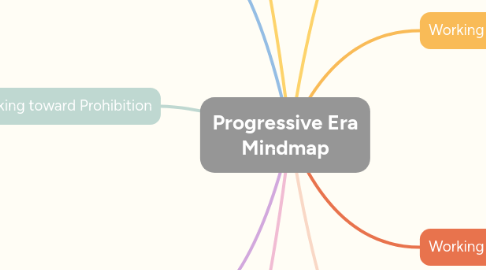
1. Working to end Child Labor
1.1. The National Child Labor Committee (NCLC) (Organization dedicated to ending all child labor formed in 1904) and Lewis Hine (Took photographs of children working in factories to show just how bad it was)
1.1.1. Compulsory Education Laws - A law that required kids to attend school and keep young children from having to work dangerous jobs.
2. Working to end Poverty
2.1. Crowded Tenements (Crowded and rundown houses that were for rent for those who couldn't afford their own house) and Urban Slums (Neighborhoods of Tenement houses)
2.1.1. Jacob A Riis (Took photos of these tenements and showed society to gain awareness) and Jane Addams (Helped these people by opening the first Settlement house)
2.1.1.1. Settlement Houses - These were houses that were much less crowded and much safer with education opportunities, child care, and work training)
3. Working toward Prohibition
3.1. Alcoholism (Uncontrolled drinking) and Immorality (wickedness)
3.1.1. Mary Hunt (Thought that prohibition would promote morality and better health) and Carrie Nation (Prohibition advocate that went as far as taking a hatchet to saloons) and Women's Christian Temperance Union (Temperance Movement) (Thought that prohibition would promote morality and better health)
3.1.1.1. 18th Amendment - Banned the manufacture and sale of alcohol
3.1.1.1.1. Speakeasies (Illegal nightclubs that sold alcohol) and Bootleggers (People who made money by transporting selling liquor illegally) and the Growth of Organized Crime (A category of transnational, national, or local groupings of highly centralized enterprises run by criminals to engage in illegal activity, most commonly for profit)
4. Working towards Health & Safety
4.1. Contaminated Food (The presence of unwanted elements in food) and Lack of Healthcare (Uninsured adults are less likely to receive preventive services for chronic conditions such as diabetes, cancer, and cardiovascular disease)
4.1.1. Upton Sinclair (Wrote the novel The Jungle exposing the lack of safety and sanitation in the meat packing industry) and Alice Hamilton (A doctor who helped factory workers) and Lillian Wald (A nurse who had the idea of sending nurses to people who were to sick or to poor to go to a hospital)
4.1.1.1. Pure Food and Drug Act (These regulations banned the sale of impure foods and medicines) and Visiting Nurse Program (Nurses would travel to peoples houses to help them if they were to sick or couldn't afford a hospital)
5. Working towards Suffrage
5.1. Women didn't have the right to vote (Women did not have the right to vote at this time and they were working to get this right)
5.1.1. National American Woman Suffrage Association (NAWSA) (Working to get each state to allow women to vote)and Elizabeth Cady Stanton (The first president of NAWSA) and Susan B. Anthony (The NAWSA president in 1892)
5.1.1.1. 19th Amendment - Gave women the full right to vote
6. Working to end Corruption
6.1. Political Machines (ex. Tammany Hall) - These machines were organizations that influenced votes and controlled local governments. Tammany Hall was the most famous machine in New York City)
6.1.1. Robert M. La Follette - Was the president of Wisconsin when they became the first state to have a direct primary. A direct primary was when the voters could choose candidates to run in elections.
6.1.1.1. Direct Primary - Where voters could choose candidates for the parties to run in elections.
7. Working to end Racism
7.1. Jim Crow Laws (laws enforcing segregation) and Segregation (separation of white and blacks)
7.1.1. Ida B. Wells (An African American journalist working to fight against black lynchings in the south) and W.E.B. Dubois (Helped start the National Association for the Advancement of Colored People [NAACP]) and Booker T. Washington (An early leader in the effort to achieve equality and founded the Tuskegee Institute)
7.1.1.1. National Association for the Advancement of Colored People (NAACP) (This group worked hard to end discrimination African Americans in the United States) and The Tuskegee Institute (This school helped African Americans learn trades and gain economic strength)
8. Working towards Conservation
8.1. Loss of Natural Resources - This happens when the consumption of renewable or non-renewable resources becomes scarce, as they are consumed at a faster rate than they can be replenished.
8.1.1. John Muir (Naturalist that camped with Teddy Roosevelt to see all of the natural resources lost) and Teddy Roosevelt (The U.S. President at the time that had noticed the depletion of resources)
8.1.1.1. Wildlife Refuge (An area designated for the protection of wild animals, within which hunting and fishing are either prohibited or strictly regulated) and National Parks (An area set aside by a national government for the preservation of the natural environment)
9. Working towards Worker's Rights
9.1. Low Wages (Wages lower than two-thirds of the median salary in the population) and Long Work Days (Work schedules having longer than normal workdays)
9.1.1. Samuel Gompers (Fought for laws that would limit the work day to 8 hours) and American Federation of Labor (AFL) (Started by Samuel Gompers and worked to make changes in workplaces)
9.1.1.1. Labor Unions (Organizations that represented workers in many industries) and Employees going on Strike (When the workers would stop working until they got what they wanted)
